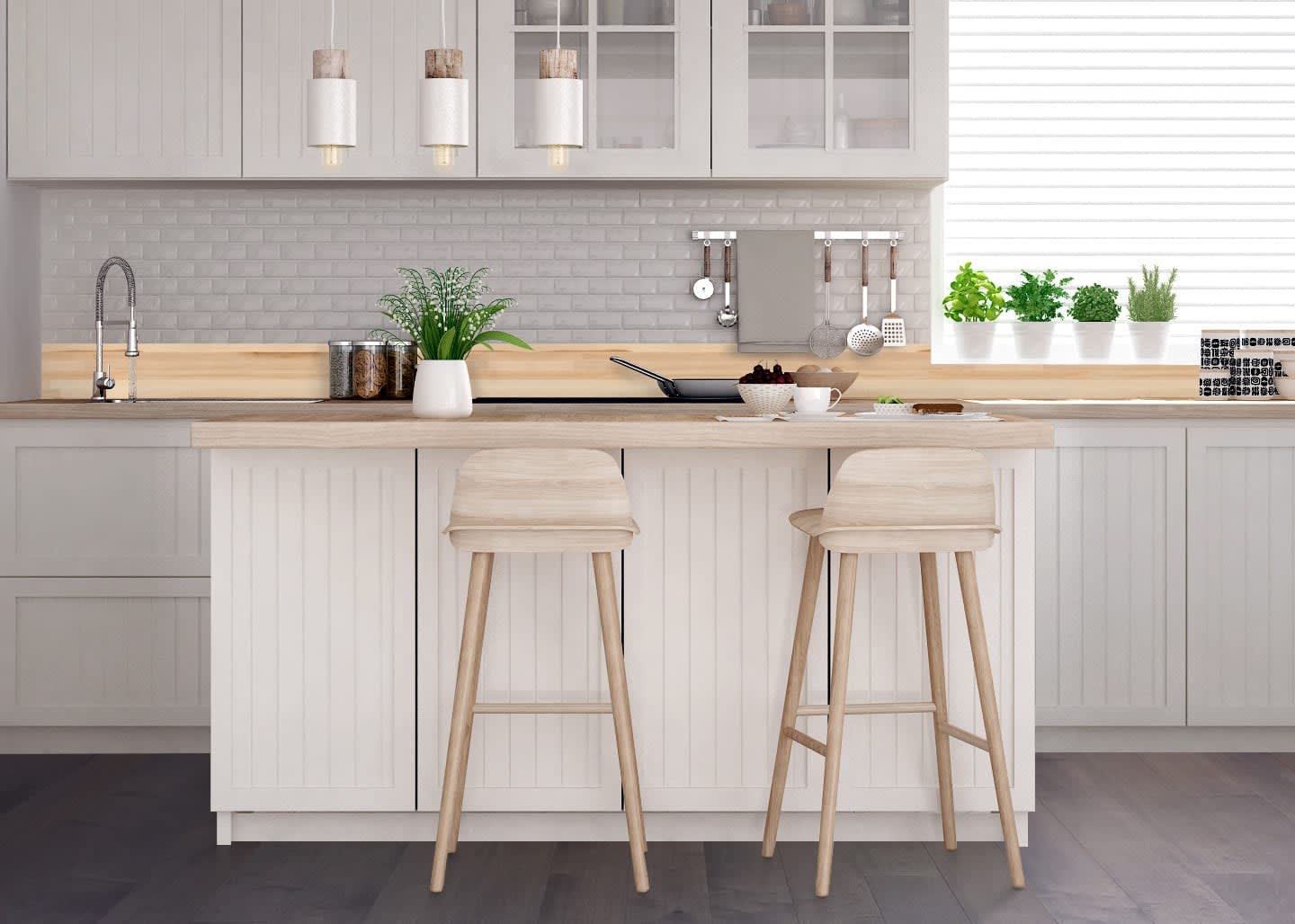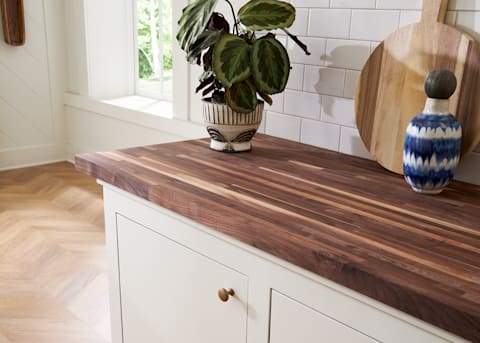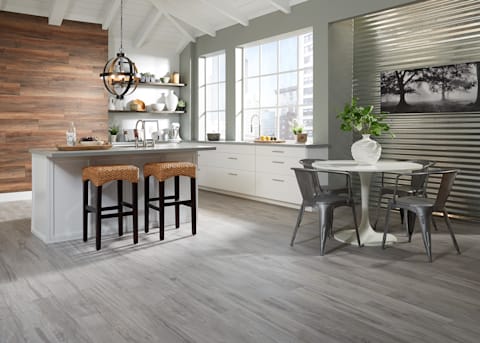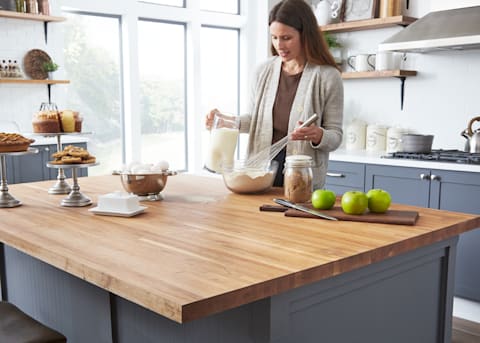- Home
- Education
- Buying Guides
- Buying Guide: Shop for Backsplash
Buying Guide: Shop for Backsplash
Shop for a backsplash that complements your kitchen or bathroom design.
Backsplashes add an attractive focal point to kitchens and bathrooms while protecting walls from water and grease splashes. Both functional and beautiful, a backsplash is a crucial part of your space. To shop for a backsplash that fits your needs, it's important to consider material, style, cost, and a few other factors.

Considerations When Shopping for Backsplash
Your first step in learning how to shop for backsplashes is understanding the differences between the many types of backsplashes available.
Here are a few key features to look for..
Backsplash Materials
Backsplashes come in various materials, including ceramic, metal, glass, porcelain, stone, and travertine. Your decision will depend on several factors, including cost, style, color, and texture. However, there's more to consider with each material, and some might be a better choice than others for your project.
Tile
Porcelain tile backsplashes repel water well and come in a variety of designs, textures, and colors. These tile backsplashes can create just about any pattern you'd like for your kitchen or bathroom. They're also relatively low-maintenance and easy to keep clean. Wipe tile backsplashes down with a soft sponge and warm, soapy water at least once a week to keep them looking their best.
Glass
Glass backsplashes give a smooth, modern look to a space. Their surface is shiny and reflective, making them especially handy in smaller spaces that could use more light and an open feel. Use a clean, soft cloth and a mixture of warm water with a splash of dish detergent to wipe down glass tiles weekly.
Stone
Natural stone backsplashes add a one-of-a-kind style to a kitchen or bathroom. They are suitable for several different aesthetics, such as rustic and upscale. This type of backsplash offers great performance but does require sealing regularly to maintain stain and water resistance. It also provides long-lasting protection in spaces used frequently. Travertine is one of the most popular types of stone tiles used in modern homes. Use a non-abrasive scrub pad and warm, soapy water to gently lift dirt from a stone backsplash's crevices.
Wood
Wood backsplashes offer nice contrasts to stainless steel, granite, and other materials used in kitchens and bathrooms. You can paint or stain wood backsplashes to match your décor. Use a wood cleaner and microfiber cloth to clean your wood backsplash. If appropriate, add a layer of wood oil to seal and protect it if not permanently sealed.
Backsplash Textures
Backsplash textures vary significantly, allowing you to choose a style from ultra-smooth to a rustic natural stone texture. In addition to looks, consider the upkeep of textured backsplashes. Smoother backsplashes tend to be easier to wipe down, while highly textured tiles with several grooves and nooks can be more challenging to keep clean. Textured tiles can also sometimes hide dirt and grime.
Backsplash Colors
From pure white to midnight black, backsplashes come in all colors of the rainbow. You can also find backsplash tiles that add pops of color throughout your room. Before you shop for a backsplash, decide on your space's color theme to help you narrow your options. You might choose to mix and match colors or opt for a single-color backsplash using one hue in your color palette.
Backsplash Sizes
Backsplashes are available in squares, rectangles, and other shapes. Smaller tiles can create an eye-catching focal point, while larger tiles can help open tighter spaces. Consider the area on which you'll install your backsplash, too.
Backsplash Durability
If you plan to leave your remodel in place for several years, it's important to find a durable backsplash with the performance to match. Ceramic and porcelain are among the longest-lasting options. In contrast, glass and stone are easy to scratch and may require some extra careful cleaning and sealing practices to help them maintain their beauty over time. Be sure to use microfiber cloths or non-abrasive sponges and mild detergents when cleaning these backsplashes to avoid scratches.
Backsplash Installation
Backsplashes have grout, adhesive mix, or peel-and-stick installation. Peel-and-stick backsplashes can be much easier and quicker to install. They're also a good choice for people who might want to change their backsplash in a few years, as they're not as permanent as grout. However, grout or adhesive mix installation can be longer-lasting and more durable than peel-and-stick. Some backsplashes, such as natural stone, typically require the strong foundation that grout mixes provide.
Average Backsplash Cost
Backsplashes range in price. Manufacturers and retailers usually charge by the square foot, with prices ranging from $2 to upwards of $20, depending on the material and pattern intricacy. As a result, it's not uncommon to spend anywhere from $200 to $1,000 or more on a quality backsplash for an average-sized kitchen or bathroom. Sticking to your budget is important. Take some time to browse backsplashes you like. If it is necessary for you to keep costs down, you can narrow your choices into cost-friendly options, such as mosaic tile backsplashes.
Calculating the Right Amount of Backsplash
Before you shop for backsplash, calculate the amount you'll need to cover your space using the following steps: Measure the height and width of each portion of the wall you'd like to cover. For oddly shaped spaces, be sure to measure all areas separately, such as gaps between cabinets or a shorter area under your range hood. Multiply the height and width of each space separately to find their areas.
Then, add the individual areas together to find the total area of your project. Divide the total area by 144—the total number of inches per square foot—to find the number of square feet you'll need. For example, a small five-foot by three-foot space becomes 60 inches by 36 inches for a total area of 2,160 inches (60 x 36 = 2,160). 2,160 / 144 = 15 square feet of backsplash. Consider adding more square feet to your order to account for mishaps or slight miscalculations. A good rule of thumb is an extra 10% of square footage.
In the example above, you'd want about two additional square feet of backsplash. Backsplash can add protection, color, texture, and style to your bathroom, kitchen, or laundry area. Use our guide to determine the features you need in your backsplash, including materials, installation type, and size.
Then, shop LL Flooring's backsplash selection to find one that speaks to your project.
Do you like ideas and how-to videos about design and decor on YouTube? SUBSCRIBE to the LL Flooring YouTube Channel and get notified about new videos!





